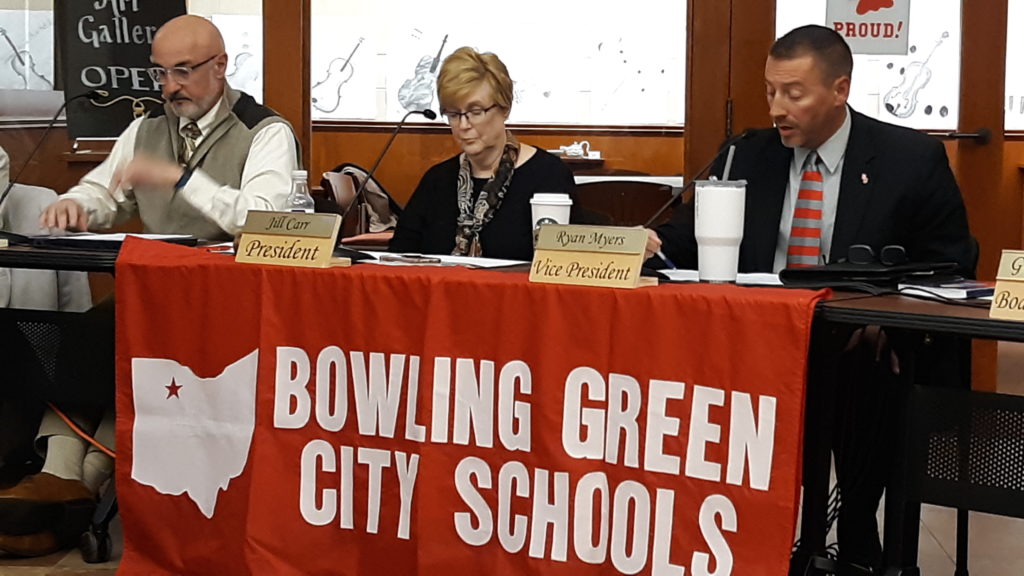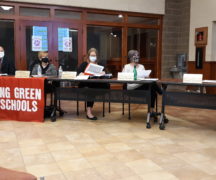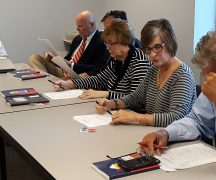By JAN LARSON McLAUGHLIN
BG Independent News
After multiple rejections by voters of a new elementary school, Bowling Green City School officials are hoping the community will show up at the polls to support plans for a new high school.
“We decided what we’ve been doing is just not working,” Tara Loar, chairperson of the school levy committee, said Tuesday in a presentation to the BG Exchange Club. “The community is divided.”
So after a community-wide effort, a school facilities committee decided to shift gears and try for a new high school.
The combined income tax and bond issue on the ballot Nov. 8 would generate $70 million for the new high school building, which would be constructed on the grounds of the current school.
If passed by voters, a 3.9-mill property tax will be collected for 30 years, and a 0.5% income tax increase will be collected for seven years.
Based on a house value of $100,000 and a median family annual income of $66,215, the property tax portion would cost $136 a year, and the income tax portion would cost $331 a year. Since the income tax would be dropped after seven years, the payments would then be reduced to $136 a year.
A school maintenance fund has been built into the income tax collection.
“We’re really excited,” Loar said, stressing that the district realizes the elementaries still need improvements. But a new high school appears to be a far less controversial project. “Let’s get something accomplished. This is the path of least resistance right now.”
Loar acknowledged that a “quiet campaign” is being led for the school issue.
“We’re not hiding anything. We’re just keeping the temperature calm,” she said. “We don’t want to fight the opposition. We want to accomplish this goal for our community.”
When discussing the building issue earlier this year, the board of education members expressed apprehension about putting a tax issue on the ballot since the last three efforts to fund a new elementary school failed – the last one by just 32 votes.
But there is some confidence that a less controversial goal of a new high school, rather than a new consolidated elementary, could get voter support.
Board of Education President Jill Carr said Tuesday evening that the board has followed the community’s lead on the ballot issue.
“The community has worked with us,” she said about the shift to the high school project. “I support that 100%.”

Board Vice President Ryan Myers presented a timeline of the facilities committee’s work that included people from a wide swath of the community.
“It’s been no secret that Bowling Green has school buildings that need to be addressed,” Myers said at Tuesday’s board of education meeting. “The board has been committed to listening to the community. This project is exactly what was recommended to us by the community – and we listened.”
Loar explained the facilities committee’s process for selecting a new high school as the most likely to get voter support. The group was made up of community members, business people, farmers and educators. They toured a new high school in Northwood, then toured Bowling Green’s school buildings.
“A lot of people had their eyes wide open,” Loar said.
At that point in the process, 99% of the committee agreed Bowling Green’s buildings needed an upgrade.
The 60-year-old high school was built for different times – with small classrooms and few electrical outlets to meet the technology needs of students.
“We know all the buildings in this district need love” aside from the newer middle school, Loar said.
However, the committee was split 50/50 on whether the district should try for one or two new elementaries.
“The division in the community is still there,” Loar said.
So instead, the committee shifted focus to a new high school, which garnered 95% support by the committee members.
Loar is hoping voters agree.
“Time is of the essence,” she said. The students deserve better educational facilities, the teachers deserve a better workplace, and the community needs a boost, she said.
Exchange Club member Clif Boutelle noted that all other school districts in Wood County have new buildings – except Bowling Green.
“I think we’re losing people. They’re going to Perrysburg and other places,” Boutelle said.
Loar said the district enrollment is down – and agreed it’s become a community issue.
“We want people to be proud. We’ve lost a little bit of that,” she said. “We’d like to get this accomplished.”
The last time the district attempted a bond issue, a citizens finance task force recommended that the issue not rely completely on property taxes.
With property taxes, the addition of new residents and new businesses in the district help bring down the amount collected from the original property owners. The district’s tax base is about 30% businesses.
With income taxes, if the community grows, the revenue will grow. But only residents of the district pay income taxes – not businesses.
Social Security income is not taxed by either property or income taxes.
District officials have said they are sensitive to agricultural property owners, who have said they will support an increase in income taxes but not property taxes. But voting records show that the rural areas of the district didn’t vote in favor of the last proposal that split the cost 50/50 between property and income taxes.
The district has also heard complaints from large rental property owners in Bowling Green, who oppose property taxes to pay for school buildings. Some signs urging a “no” vote on the high school issue have started popping up in the yards of one large landlord’s rental properties.
With interest rates and inflation climbing, the board agreed that waiting will only cost more money. Five years ago the district tried to get a levy passed to replace two elementaries and the high school – all for $72 million – compared to $70 million for just a new high school now.
If the issue passes, the timeline for the project is tentatively six to eight months for design, then two years for construction.
The board believes the short duration of the income tax – which runs out after seven years – will allow the district flexibility to address elementary building needs sooner.





